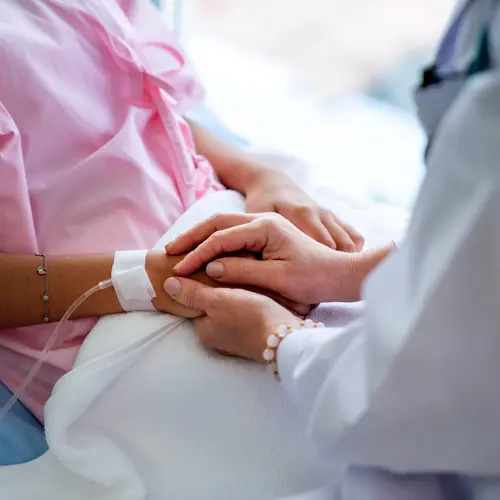Nuclear medicine can help diagnose and treat different conditions, including some forms of cancer.
In nuclear medicine, doctors put small amounts of radioactive material into your body so they can see your organs and tissues, as well as how well they work. That can help them spot tumors and see if your cancer has spread to other areas of your body. It can also help target cancer cells.
Doctors also use nuclear medicine to see if a treatment is working.
How It Diagnoses Cancer
Like X-rays, nuclear medicine is a type of radiology. But while X-rays give doctors a “big picture” view of your anatomy, nuclear imaging shows the amount of activity in your organs and tissues.
When doctors use nuclear medicine to diagnose or monitor a disease like cancer, they put things in your body called radionuclides (or “tracers”) that release low levels of radiation.
You can take radionuclides by mouth or through an intravenous (IV) drip.
After you take these radionuclides, you’ll have what’s called a nuclear scan. Scans take pictures of a specific area of your body to help doctors find tumors and other things, like infection. For example, a tumor may show up as a “hot spot” on the picture, meaning the radiation collects in greater amounts in areas where the tumor is active. Or a tumor might show up as a “cold spot,” meaning there’s actually less cell activity. That can also be a sign of cancer.
The type of scan you receive depends on what your doctors want to see. Some of the more common types of scans used to diagnose and monitor cancer include:
Bone scans. These look for cancer that has gone to your bones from other areas of your body. Nuclear medicine can sometimes find signs of bone cancer earlier than X-rays can.
Gallium scans. A radioactive substance called gallium goes into your vein through an IV.It can help your doctor spot cancer throughout your body. Gallium scans can also find other problems, like infection or inflammation.
MUGA scans. Doctors use radionuclides to see how your heart is pumping blood. That helps them figure out how well your heart works before, during, and after certain types of chemotherapy. That’s important because chemotherapy, particularly high amounts of it, can affect how well your heart works.
PET (positron emission tomography)scan. When you have this, you get an IV injection of radioactive sugar. The amount of that sugar that your cells absorb can help your doctors learn how fast your cancer cells are growing. In some cases, you would get PET scans along with computerized tomography (CT) scans. Together, these tests help doctors figure out exactly where your tumors are.
Thyroid scans. To get one of these, you swallow radioactive iodine or receive an injection. The iodine collects in your thyroid gland and helps doctors find thyroid cancer.
Nuclear medicine scans aren’t painful. The scans usually involve lying on a table while a doughnut-shaped scanning machine takes photos. The whole thing usually takes 30 minutes to an hour. In some cases, you may need to stop eating or drinking for a certain amount of time before your scan.
How Nuclear Medicine Treats Cancer
There are several types of nuclear medicine that treat cancer. They include:
Radioimmunotherapy. If you have non-Hodgkin's lymphoma that doesn’t respond to chemotherapy, your doctor may recommend this, also called RIT.
It combines radiation therapy and something called immunotherapy, a type of treatment that uses your body’s immune system to fight your cancer.
Through an IV, a doctor gives you something called monoclonal antibodies. These are man-made proteins that target certain parts of cancer cells. You also get a radioactive substance attached to those antibodies.
Together, these things latch on to cancer cells and deliver radiation directly to the tumor to kill it.
Researchers are looking to see if radioimmunotherapy can help with other cancers, like:
- Prostate cancer
- Melanoma
- Leukemia
- Colorectal cancer
- High-grade brain glioma
Radioactive iodine therapy. Your thyroid gland absorbs almost all the iodine you take in. In this treatment, radioactive iodine (also known as RAI or I-131) collects in thyroid cells, where it destroys the gland and the cells.
Unlike some other forms of radiation, radioactive iodine (also known as radioiodine) therapy does this without hurting the rest of your body. Doctors often use radioactive iodine to destroy thyroid tissue that surgery can’t remove. It sometimes also helps kill thyroid cancer cells that have spread to your lymph nodes or other parts of the body.
Brachytherapy. This procedure involves delivering high doses of radioactive material contained in seeds that are placed inside your body to kill localized cancer cells. In most cases, brachytherapy is more targeted, causes fewer side effects, and has doesn't take as long as conventional radiation therapy, which uses an external beam outside of your body to project radiation into your cells.
Sometimes, you'll get brachytherapy with other forms of cancer treatment, like chemotherapy or surgery.
Brachytherapy treats several types of cancer, including:
- Bile duct cancer
- Brain cancer
- Breast cancer
- Cervical cancer
- Endometrial cancer
- Esophageal cancer
- Eye cancer
- Head and neck cancers
- Lung cancer
- Pancreatic cancer
- Prostate cancer
- Rectal cancer
- Skin cancer
- Soft tissue cancers
- Vaginal cancer
Y90 radioembolization: This liver cancer treatment happens in two steps. In the first, a catheter goes in the artery that supplies blood to your liver. Your doctor then uses a special dye so they can "map out" the other arteries that have anything to do with your liver. The second step is when the radiation goes in. It's put onto tiny particles that can be made of glass or resin. Then, after double-checking the positioning, the radiation goes into the liver artery. The particles stick into the cancer and release the radiation directly into the tumor.

